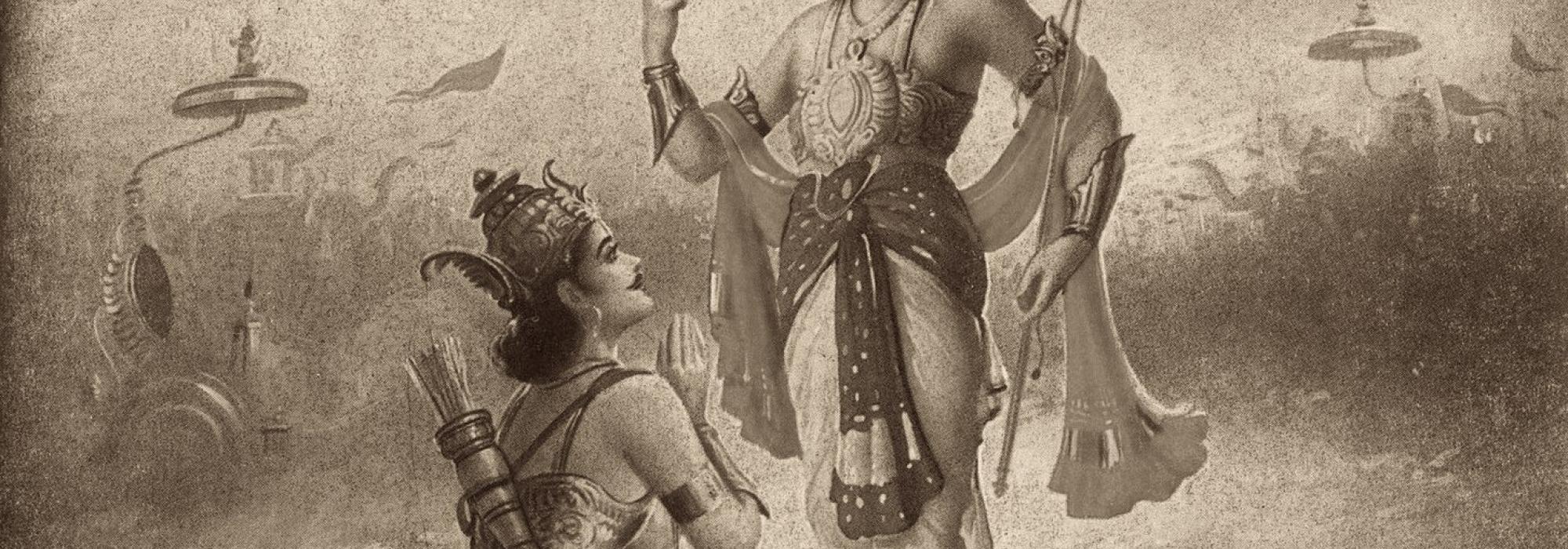2. Universal self-hood (Atmaupamya): is the perfection of knowledge; its ripe fruit. Intellectual conviction is achieved via reflection upon the śāstras and refined by life’s training. This conviction is then transformed into experience through contemplation. Such a knower sees himself everywhere. He looks upon the world with the same affection as a mother would her children. All lives are his own. Just as a mother’s life mingles with her children’s lives, the knower of the Self becomes one with the welfare of all beings. The experience of one’s own Self everywhere is another kind of adhidharma which is surrendering entirely unto Brahma.
Thus the paths for emancipation are three: 1. Devotion with surrender. 2. Following dharma prescribed by the śāstras. 3. Seeing one’s own self as the Universal Self. “Arjuna, choose any of these three paths. Do not venture into śāstric hair-splitting or debates. Have faith in me and fight for the sake of my words.” That is surrender.
Or, the Vedas declare that fighting in a war for dharma is the duty of a kṣatriya. The world is Bhagavān’s kingdom whose inhabitants are your co-subjects. Establishing justice among them is therefore the worship of the divine. You can fight with this perspective in mind as well. This is being obedient to dharma.
Or, go beyond the three guṇas! As the world is but a līlā of Supreme Brahma, you can fight thinking thus - “I am but a wave in this ocean of Brahma’s pastimes. I am a throb in this great roiling of the world. I should hence be one with it and sublimate my “I”-ness in it”! This is experiencing Brahma’s presence. It is also the experience of one’s own self everywhere.
You have these three paths. Choose one of these three - one that suits you, one for which you are capable and ready, and one that your mind likes. Decide that path for yourself.”
vimṛśyaitadeśeṣeṇa yathecchasi tathā kuru ||
Having said this, Bhagavān asked - “Have your ignorance and delusion subsided?” Arjuna replied :
naṣṭo mohaḥ smṛtirlabdhā...
kariṣye vacanaṃ tava ॥
O Acyuta, due to your grace in the form of your teaching, all my doubts have been destroyed. I will do as you say.
Then started the war.
After listening to this conversation between Kṛṣṇa and Arjuna, Sañjaya submitted to Dhṛtarāṣṭra:
yatra yogeśvaraḥ kṛṣṇo yatra pārtho dhanurdharaḥ ।
tatra śrīrvijayo bhūtirdhruvā nītirmatirmama ॥BG 18.78
ಯೋಗಪತಿ ಕೃಷ್ಣನುಂ ಧನು-
ರಾಗಮಪತಿ ಪಾರ್ಥನುಂ ಮತೈಕ್ಯದೇ ಧರ್ಮೋ-
ದ್ಯೋಗದಿ ತೊಡಗಿಹ ಪಕ್ಷದಿ
ಭಾಗ್ಯಶ್ರೀ ನೆಲಸಿ ನಲಿವಳದು ನಿಶ್ಶಂಕಮ್ ॥
yogapati kṛṣṇanuṃ dhanu-
rāgamapati pārthanuṃ mataikyadè dharmo-
dyogadi toḍagiha pakṣadi
bhāgyaśrī nèlasi nalivaḻadu niśśaṃkam ॥
“When the lord of yoga, Kṛṣṇa and
the lord of archery, Arjuna,
act together for dharma,
the goddess of auspiciousness lives
and delights there, without a doubt!”
ತತ್ತ್ವವಿವೇಕದ ಯೋಗಂ
ಕ್ಷತ್ರಿಯವೀರ್ಯಪ್ರಯೋಗಮೀಯುಭಯಮುಮೇ
ಕತ್ವದೊಳಿರೆ ಜಯಸುಖಸಂ-
ಪತ್ತುಗಳುಂ ಧರ್ಮನೀತಿಯುಂ ಸಂಸಿದ್ಧಮ್ ॥
tattva-vivekada yogaṃ
kṣatriya-vīrya-prayogamīyubhayamume-
katvadoḻire jayasukhasaṃ-
pattugaḻuṃ dharmanītiyuṃ saṃsiddham ॥
When the yoga of the knowledge of the ultimate principle
and the valorous practice of kṣatra are in unison,
Victory, happiness, wealth, and
the rule of dharma are well established.
|| OM TAT SAT ||
Gist
ಹರಿಶರಣತೆ ಸ್ವಕರ್ಮಾ-
ಭಿರತತೆ ಮಿತಭೋಗತೃಪ್ತಿಯೀ ತ್ರಿವ್ರತದಿಂ ।
ಪರಿಶುದ್ಧಿಯಾಂತು ಜೀವಂ
ನಿರಹಂಕೃತಿಯಿಂ ಪರಾತ್ಮಶಾಂತಿಯ ಪಡೆಗುಂ ।। ೧ ।।
Purified by this vrata-triad of
surrender to Hari, engagement in one’s own duty,
and contentment in limited pleasure,
the jīva becomes egoless and attains supreme tranquility.
ಗುರುಶಾಸ್ತ್ರವಿಧೇಯತೆಯಿನೊ
ಹರಿಪದಕೆ ಸಮರ್ಪ್ಯಮಾತ್ಮಮೆಂಬಾಸ್ಥೆಯಿನೋ ।
ಪರಿಗತಸಾರ್ವಾತ್ಮ್ಯದಿನೋ
ಶರಣಂ ಬ್ರಹ್ಮೈಕಮೆಂದು ಚರಿಸುವವನಘಮ್ ।। ೨ ।।
Through obedience to guru and śāstra,
or the faith that one’s self has to be surrendered at Hari’s feet,
or contemplation on omnipresent universal self-hood,
the blemishless one surrenders to the one Brahma.
ನಿಷ್ಠಂ ತಾಂ ಬ್ರಹ್ಮದೊಳಿರ-
ಲಿಷ್ಟಾನಿಷ್ಟಕೃದಹಂತೆ ನಿರ್ಮೂಲಮಿರಲ್ |
ದುಷ್ಟತೆಯವನೆಡೆಯಿರದೆಂ-
ಬಷ್ಟಾದಶದಿಂ ಸಮಾಪ್ತಮೀಶ್ವರಗೀತಮ್ || ೩ ||
When established in Brahma,
when the ego that causes likes and dislikes is uprooted,
no evil exists with him.
Thus concludes the song of Īśvara in the eighteenth.
ಭೂತಲಪರಿಶ್ರಮಿಗೆ ಸಂ-
ಗೀತಂ ಶ್ರಮಹಾರಿ ಸುಖದಮಂತೆಯೆ ಭಗವ-
ದ್ಗೀತಾಗಾನಂ ಲೋಗರ
ಚೇತಃಕ್ಲೇಶಗಳ ಕಳೆದು ಶಾಂತಿಯ ಕುಡುಗುಮ್ ।।
Just as music rids the farmer
of fatigue and gives joy,
the song of Bhagavān removes
the world’s mental distress and bestows peace.
The Gist of the third sextet
ಆತ್ಮಾನಾತ್ಮವಿವೇಕಂ
ಸತ್ತ್ವಮಯಶ್ರದ್ಧೆ ಭಗವದರ್ಪಿತಜೀವಂ ।
ತತ್ತ್ವಾಪ್ತಿಗೆ ಸಾಧನಮಿವು
ಮುಕ್ತಿಪದಂ ಜ್ಞಾನಮೆಂಬುದಂತಿಮಷಟ್ಕಮ್ ।।
"Discernment between self and non-self,
Faith permeated by sattva, and a life offered to Bhagavān
are the means to achieve the supreme principle.
The state of mukti is knowledge." -
thus states the final sextet.
ವಿವಿಧಮತಗಭೀರಂ ಸಾಮರಸ್ಯಪ್ರಕಾರಂ
ಗೃಹಿಯತಿಸಮುದಾರಂ ಸರ್ವಜೀವೋಪಚಾರಮ್ ।
ಸುರನರಸಹಕಾರಂ ಸ್ವಾತ್ಮಸಾರ್ವಾತ್ಮ್ಯಸಾರಂ
ಭವಜಲನಿಧಿಪಾರಂ ಕೃಷ್ಣಗೀತಾವತಾರಮ್ ।।
Deep with various thoughts, the means towards harmony,
Generous to both householders and monks, a consolation to every jīva,
Helping both deva and man, the essence of Universal selfhood,
Deliverer across the ocean of saṃsāra, is the incarnation of Kṛṣṇa as the Gītā.
ವೇಣುಸ್ವಾನಸ್ಫುರದಧರದಿಂ ಶಂಖನಿರ್ಘೋಷರೌದ್ರಂ
ಗೋಪೀವಸ್ತ್ರಾಹರಣಕರದಿಂ ಚಂಡಚಕ್ರಪ್ರಹಾರಮ್ ।
ದ್ವಂದ್ವೈಶ್ವರ್ಯಂಗಳೊಳಮವನಿಂತಿರ್ದುಮದ್ವಂದ್ವಸತ್ತ್ವಂ
ಚಾಲಿಕ್ಕೆಮ್ಮಂ ನಿಜಚರಣಕಾ ವಾಸುದೇವಾಖ್ಯತೇಜಮ್ ।।
The terrific roar of the śaṅkha issued from the lips that play the flute.
The destructive cakra was dispatched by the hand that stole the Gopīs’ garments,
The essence beyond opposites that resided amidst battles and wealth,
May that radiance known as Vāsudeva lead us to its feet.
The gist of the three parts
ಭಕ್ತಿ ತ್ರಿವಿಧಂ ಧರ್ಮ-
ವ್ಯಕ್ತಂ ಧ್ಯಾನಪ್ರಯುಕ್ತಮ್ ಆತ್ಮಜ್ಞಾನೋ -।
ಪಾತ್ತಮ್ ಅನುಕ್ರಮದಿಂ ಸಂ-
ಪ್ರೋಕ್ತಮಿದಧ್ಯಾಯಷಟ್ಕಕಾಂಡತ್ರಯದಿಂ ।।
The tri-fold bhakti - expressed through dharma,
applied through dhyāna, and attained through self-knowledge
has been enumerated respectively in the three chapter-sextets.
ಸ್ವೀಯಮಧುರಸವೀಂಟ ಕಾಯಕೋಟಿಗಳಿಂದೆ
ಮಾಯೆಯೊಡನಾಡಿ ವಿಶ್ವದೊಳವಳ ನಖದಿಮ್ |
ಗಾಯವಡೆದಳುತಲೆಚ್ಚೆತ್ತು ತತ್ತ್ವವನರಸಿ
ಸಾಯುಜ್ಯವೆಳಸುತಿಹುದಾತ್ಮಂ ವಿಚಿತ್ರಮ್ ||
’Tis strange that the self, having embraced Māyā in the world
through a billion bodies oozing her sweet nectar,
wakes up crying after being wounded by her nails, and
seeks out the ultimate principle, longing for unity!
ಮಾನುಷ್ಯಾಂತಃಕರಣಬಲದೌರ್ಬಲ್ಯಚಾಪಲ್ಯನಿಮ್ನೋ-
ತ್ತಾನೋತ್ತಾಲಂಗಳನರಿತು ಜೀವಾರ್ಹಸಾಹ್ಯಂಗಳಂ ಸಂ-|
ಧಾನಿಪ್ಪಾತಂ ಪರಮಪುರುಷಂ ಧರ್ಮರಕ್ಷೈಕದೀಕ್ಷಂ
ಸ್ವಾನಂದಾಸೇಚನಚಣ ಘನಶ್ಯಾಮಲಂ ಕೋಮಲಾತ್ಮಮ್ ||
Having understood the inner rhythms of human strengths, weaknesses, and caprices,
and its ups and downs, the supreme puruṣa harnesses help suitable for each jīva.
He has the protection of dharma as his sole goal,
the dark cloud that is celebrated for raining its own bliss, the tender one.
|| iti śam ||
Note
ಕಾಲವಿಪರ್ಯಾಸದಿ ಕಲಿ-
ಯಾಳಿಕೆಯಲಿ ವರ್ಣವೃತ್ತಿಗೃಹಸಂಕರದೊಳ್ ।
ಬಾಳು ಗುರಿ ತಪ್ಪದಂದದಿ
ಚಾಲಿಸಲಿಹ ಬೆಳಕು ನಮಗೆ ಗೀತಾದೀಪಮ್ ।। ೧ ।।
In adverse times, in the reign of Kali,
amidst commingling of creeds, guilds and clans,
our light to lead life without going astray,
is the lamp of the Gītā.ಕಷ್ಟಂ ಬಹಿರಾಚಾರಂ
ದೃಷ್ಟಿಯೊಳಿರ್ಕಂತರಂಗ-ಶುಚಿತೆ-ಯದೆಂದುಮ್ ।
ದುಷ್ಟಗಳ ನಡುವೆ ಭಗವ-
ನ್ನಿಷ್ಠೆಯೊಳಾತ್ಮವನು ನೆಲಸೆ ಗೀತಾಭ್ಯಾಸಮ್ ।। ೨ ।।
Difficult is external practice ever,
while the focus is on inner purity.
Establishing the self in Bhagavān,
even amidst evils, is the practice of the Gītā.
Gist
It is possible to find solutions to contemporary problems such as the crumbling edifice of the varṇa system, complications concomitant with new professions, and the issues stemming from contact with other countries and cultures by applying the Gītā in our lives. However, such solutions require firm trust in the efficacy of the Gītā as well as an understanding of its universal principles borne out by reasoned reflection. Teachings of the Gītā such as the acceptance of the principle of dharma and restraint in pleasure are applicable to all of mankind.
Myriad are reasons for mental turmoil - be they political disarray, economic competition, employer-employee friction, the primacy of making money, or squabbles among nations. Even so, it is not impossible even today to make a just living. It is possible as well as imperative, even now, for the devotees of the Gītā to maintain, among others, a restraint in pleasure, moral rectitude, and the sanctity of the man-woman relationship.
We have insisted again and again in this lecture series that the Gītā teaches the primacy of human effort. It is the same teaching that is dwelt upon in this concluding chapter. Human effort tempered by bhakti is indeed the redeemer. To that extent, the modern scientific quest for truth, courage, and enthusiasm for life are necessary for us.
To be continued...
The present series is a modern English translation of DVG’s Kendra Sahitya Akademi Award-winning work, Bhagavad-gītā-tātparya or Jīvana-dharma-yoga. The translators wish to express their thanks to Śatāvadhāni R Ganesh for his valuable feedback and to Hari Ravikumar for his astute edits.















































